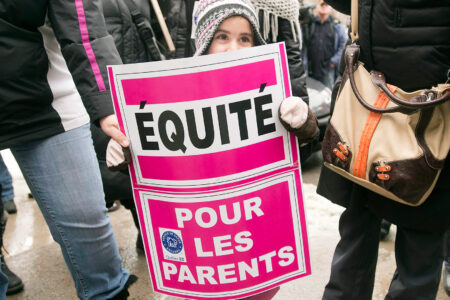
A report on household economics, issued by Statistics Canada in March, presented a snapshot of key indicators about how the financial well-being of Canadians evolved during the pandemic. Driven by record increases in government support measures, the lowest-income households saw a rise in income of almost 37 per cent over the first three quarters of 2020. The youngest households recorded the greatest gain in their net worth. Consequently, the gap between incomes of the lowest and highest earners dropped in 2020 as economic activity recouped in the third quarter. Higher income coupled with lower spending due to lockdowns brought about unprecedented gains in net savings. There were other reported gains, too. Wealth for the lowest-income bracket grew the most, owing to surges in the value of their real estate holdings.
But this doesn’t really tell the whole story. It is imperative to remind ourselves that these aggregate figures mask the divergent experiences of different groups of Canadians, and hide growing inequalities between the employed and those facing dwindling financial security. This will create challenges for governments as they try to design an appropriate mix of policies for the recovery phase of the pandemic. Because there are so many different ways Canadian families are coping in a COVID-19 economy, no one-size-fits-all response is expected to work effectively.
Many Canadians continue to struggle with financial uncertainty, according to MNP Ltd.’s consumer debt index. This has necessitated going without not just recreational spending but also foregoing many essentials. The report reveals that the improvement in savings did not carry through to the third quarter for households belonging to the lowest-income groups. On the other hand, richer and university-educated Canadians are saving more due to lower spending on travel and entertainment. With record low mortgage rates, many have used their home equity to buy recreational properties or new homes better suited to their new reality of remote working. These trends together suggest a further widening of the savings gap between the rich and poor Canadians seen over the last two decades (Figure 1).
In the context of rising dissaving by the poor – when you spend more than you make – and its macroeconomic implications, there are vital lessons to be learnt from historical data and from studies conducted for other advanced countries. In a research article by Atif Mian, Amir Sufi and Ludwig Straub, the rise in savings by Americans at the top of the income distribution scale is directly connected to the rise in income inequality. The authors attribute growing income gaps between the rich and poor Americans to the twin phenomena of rising debt and declining interest rates since the early 1980s. Their work indicates that the increase in savings by the top one per cent, what they refer to as the “saving glut of the rich,” has not been accompanied by a rise in investment, and instead has been absorbed in a less conventional manner through dissavings by the government and the rest of Americans.
The precise mechanisms through which the top one per cent in Canada have accumulated savings in the recent past closely imitate the U.S. experience. We have seen that higher savings of rich Canadians are largely accounted for by their increase in holdings of financial assets. In contrast, the dissaving by poorer households has been driven by heightened borrowing as well as a decline in the accumulation of financial and real assets. Sadly, one may expect the existing inequalities to worsen in the wake of COVID-19.
Lately, a lot of attention has been paid to the possibility of a K-shaped recovery, denoting an uneven economic upturn, amplifying financial disparities that existed before the pandemic. The basic idea is that the pandemic is having considerable adverse economic effects on some parts of the economy while having a positive effect on others. The deep divide between the rich and poor is often described in multiple, often-overlapping frameworks. At the forefront of this discussion are the soaring income and savings gaps. Figure 2 plots the progression of the share of income earned by Canadians in the top and bottom percentiles before the pandemic.
The divide is noticeable in the Canadian real estate market as well, which has helped sustain the fortunes of older and higher-earning Canadians. High-rise condos increased only slightly in value compared to the more popular low-rise homes. On a related note, a Statistics Canada study has found that intergenerational income mobility has significantly dropped across all of the cohorts. The already widening gap is predicted to worsen, with the children of baby boomers most likely to see the benefits of their parents’ wealth, as opposed to the generation of kids born from parents of other generations in the lowest income bracket.
A somewhat more obscure, longer-lasting impact of the pandemic is on the marginalized groups, making extreme inequality inevitable in the near future. Women have borne the brunt of the crisis, primarily due to unpaid caregiving responsibilities, widening the gender gap and increasing the possibility of them pulling out of the labour market entirely. An asymmetrical picture also emerges as low-wage jobs (for example, hotel cleaning staff and retail workers) have been lost, while a surge in high-wage jobs is anticipated. Many small businesses have been forced to shut down, while companies that can function remotely or that have capitalized on pandemic-related trends are booming.
There are also growing concerns about the strong association between high infection rates and low-income, visible-minority status. Data from Montreal, Toronto, and other ethnically and culturally diverse neighbourhoods, suggests strong correlations linking higher rates of infections with neighbourhoods with higher percentages of racialized residents.
The unpleasant reality we face today is that the pandemic has brought in extra cash and soaring asset values for the rich, and it spells financial doom for the poor. Undoubtedly, the government’s efforts to counteract the financial blow of the pandemic are commendable. Nonetheless, the true cost of the pandemic will become apparent as governments start to roll back their temporary relief programs. Tax hikes on capital gains and excessive profits are widely advocated policy recommendations. But a lot more needs to be done to address the sizeable social divide projected over the years to come.
Fiscal policy needs to direct spending toward groups expected to lose due to the structural transformation caused by the pandemic, so they are not left far behind those that flourish. As suggested by Oxfam Canada in its reports on The Inequality Virus, fairer economies are the key to rapid recovery. The solution may be as simple as introducing support measures to facilitate parents to get back to work in the form of access to affordable child care, as well as the provision of vocational training and education to those who have permanently lost their jobs due to the shift in the nature of work that rendered their skills obsolete. Additionally, various sector-specific changes may be necessary. For example, there is a pressing need to raise the supply of homes for rent or purchase because COVID-19 has stimulated further demand for additional housing.
The challenge facing policy-makers is to acknowledge that the aggregate figures hide an enormous degree of heterogeneity across households and must be taken with a grain of salt. It is crucial to remember what the crisis has revealed so far, and take immediate steps to mitigate the financial blow to the marginalized groups in the true Canadian spirit of inclusivity. All recovery plans need to aim at minimizing the long-term economic distress of the pandemic, and to ensure a smooth transition to the new normal.








